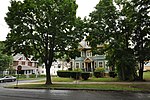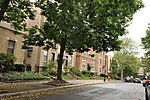West End North Historic District
Hartford, ConnecticutHistoric districts in ConnecticutHistoric districts on the National Register of Historic Places in ConnecticutNational Register of Historic Places in Hartford County, ConnecticutWest Hartford, Connecticut

The West End North Historic District encompasses a neighborhood of late 19th and early 20th century residential architecture in western Hartford, Connecticut and eastern West Hartford, Connecticut. Roughly bounded by Prospect, Elizabeth, and Lorraine Streets and Farmington Avenue, the area includes a large number of Colonial Revival and Queen Anne houses, as well as numerous buildings in other period styles, with only a small number of losses. It was listed on the National Register of Historic Places in 1985.
Excerpt from the Wikipedia article West End North Historic District (License: CC BY-SA 3.0, Authors, Images).West End North Historic District
Cone Street, Hartford
Geographical coordinates (GPS) Address Nearby Places Show on map
Geographical coordinates (GPS)
| Latitude | Longitude |
|---|---|
| N 41.769166666667 ° | E -72.712222222222 ° |
Address
Cone Street 6
06105 Hartford
Connecticut, United States
Open on Google Maps










